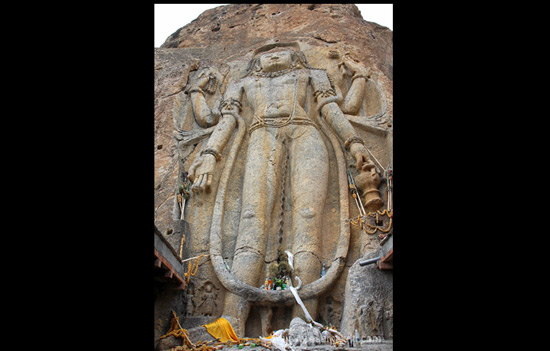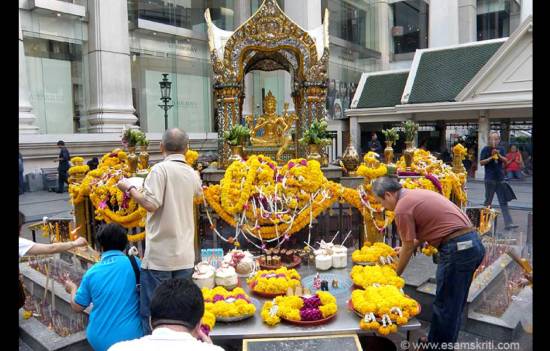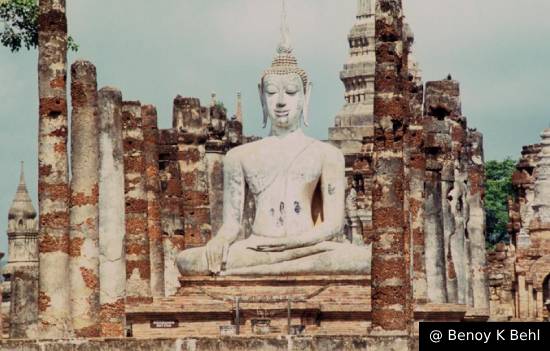- Ambedkarties do not believe in Karma & Nirvana, key elements of Indian thought. The Pali word for Dharma is Dhamma. Guruji Goenka wrote that references to Vipassana are in Ṛg Veda. Ambedkar’s was a socio-political movement. Why did Ambedkar adopt Buddha, not Guru Nanak or Mahavir?
Ever since the unfortunate throwing of a shoe at Chief Justice Gavai and show of strength by Neo Buddhists on Social Media the focus is on Navayana Buddhism introduced by Dr Ambedkar (BRA). eSamskriti has already published the following related articles – Who is a Neo Buddhist, Samkhya and
Buddhism,
A
SAKTA Critique of the VAJRAYANA Conception of Tantra and Theravada
Buddhism as an Iteration of Classical Hindu Ascetic Praxis
At
the outset, I must state that am a fan of (BRA because of his understanding of
the sub-continent Muslim mind. The intent of this article is to provoke
thought.
1. Is Navayana a School of Philosophy?
No. Before we read how Navayana is different from Buddha’s Buddhism we must know that Philosophy is a Western word that mainly relies on intellectual pursuit. The corresponding Indian word is Darsana which
relies upon direct vision of truths (experienced by sages) and pure Buddhi
(reasoning). 1
India
has nine darsanas meaning nine
ways to achieve self-realisation namely Nyaya, Vaisheshika, Sakhya, Yoga, Mimamsa, Vedanta, Carvaka, Jaina and Buddha.
Others are a mixture of the ideas of these systems. 1 Note that there is no Hindu school of philosophy. Sikhism is
Distilled Vedanta. No Navayana school.
2. What are Common Characteristics of Indian Philosophy?
Pandit Rajmani
Tugnait, spiritual head of the Himalayan Institute, outlined these in Seven Systems of Indian Philosophy. They are, “direct experience, acceptance of authority, harmony amongst schools, parallel growth and co-existence of many schools, open mindedness, support of logic and reasoning, belief of eternity, law of karma, moral and ethical teachings, acknowledgement of suffering, thoroughness, practicality and being inward looking” were common characteristics. Read Characteristics of Indian Philosophy
Neo
Buddhists (Ambedkarites) do not believe in law of karma/rebirth and
Self-realization thus negate core beliefs of Indic thought.
What about Jains? “The term JAINA is derived from the term ‘Jina’. And the term ‘Jina’ is the common name for the supreme souls who are totally free from all the feelings of attachment, etc that defile the soul. It is a noun from the Sanskrit verbal root ‘ji’ meaning ‘to conquer. And devotees of Jina care called Jaina.” 2
Actually, when BRA adopted Buddhism “The Maha Bodhi, a famous Buddhist journal in India opined that in The Buddha and His Dhamma, BRA’s interpretation of the theory of Karma, Ahimsa & that Buddhism was merely a social system, constituted not the correct interpretation of Buddhism but a new orientation.” 4 Pg 521
3. Then, who are Neo Buddhists in short?
A Professor of Buddhist Philosophy in Maharasthra says, “Neo-Buddhists are those who converted to Buddhism under the leadership of Dr Ambedkar. They are Buddhists, but with a clear focus on social justice. They take vows which Ambedkar wrote out, renouncing Hindu Gods and rituals, dedicating themselves to the Buddhist path instead.”
BRA did not
adopt Hinayana or Mahayana Buddhism but founded Navayana. His followers are called
Neo Buddhists. For BRA, it was social reform and
political mobilization. That is why Buddhist critics say that the Dhamma
preached by BRA is not Buddhism but Ambedkarism. 1 Pg 523
A
research paper by Pradeep Gokhale, Central University of Tibetan Studies, Sarnath
titled Ambedkar and Modern Buddhism:
Continuity and Discontinuity 9
and his talk 14 states,
1. “In his The Buddha and His Dhamma Ambedkar included in great proportion the elements of Theravāda Buddhism in a demythologized and secularized form. But he also included some Mahāyāna elements by dissociating them from idealistic metaphysics. For instance he made pāramitā doctrine applicable to all, which in the Theravāda had a restrictive application, and included it in the Buddha’s first sermon.” Read Theravada Buddhism
as an Iteration of Classical Hindu Ascetic Praxis
“Before deciding to embrace Buddhism BRA was thoroughly grounded in modern values. He was influenced by the values of the French Revolution.” 9 Keep in mind that BRA’s Intellectual Mentor at Columbia University was American
philosopher John Dewey. (per Search).
2. Three Features of Buddha’s Dhamma-it is not religion but morality. Buddhism advocates Liberty, equality and fraternity and can answer Marxism. Second feature were socio-political principles based on French Revolution. Gradually he made them as religious principles. Later on, he reinterpreted these appropriated these as part of Buddha’s message as said in All India Talk in 1954. The
purpose of religion is to make the world a kingdom of Righteousness. 14 Righteousness is Dharma!
3. “Naturally these values became the criteria for the choice of Buddhism as the new religion and also became the principles of reinterpretation and reconstruction of Buddhism. Probably, this is one of the reasons why Ambedkar's reconstruction of Buddhism is more radical than that of many others.” 9
Pg. 19
4. BRA’s Nayavana “Questions the traditional Karma-rebirth framework, gives a materialistic interpretation of the rise of consciousness; regards dhāmmic pursuit and achievement as essentially social and does not attach a central role to meditation.” 9 Pg 19, 14
4. Please introduce me to Buddha’s Buddhism.
British
Council Scholar, Author, Spiritualist, Historian Dr Satish Kapoor wrote in Introduction to Buddhism, “The six Buddhas (‘enlightened ones’) traditionally believed by the Theravadins to have preceded him are: Vipassin, Sikhin, Vessabhu, Kaku-sandha, Konagamana and Kassapa. The Buddha (Enlightened One) who is still to come to redeem mankind is Metteyya (Maitreya).”
“One night, he slipped out of the palace and reached Vesali where he became a disciple of Alara Kalama (also known as Arada Kalama) a scholar of the Samkhya school of philosophy.”
“The doctrine of karma is an essential part of the gospel of Buddha. A popular verse often ascribed to Buddha says: Na
pranasyanti karmani kalpa-koti-satairapi; Samagrim prapya kalam ca phalanti
khalu dehinam. Karmas do not perish even after the lapse of a million years. They fructify without fail when time and environment are suitable.” First published in Prabuddha Bharata
 Maitreya who is an 'embodiment of the great love of all the Buddhas. Village enroute to Kargil.
Maitreya who is an 'embodiment of the great love of all the Buddhas. Village enroute to Kargil.
This
was carved about first century A.D. For more see pics
24 to 26 of my album
and Pics 12 to 14 of Thiksey Monastery,
Ladakh
5. Then why did Ambedkar adopt Buddhism?
In
a May 1956 broadcast titled Why I like
Buddhism and how it is useful to the world in its present circumstances he
said, I prefer Buddhism because it gives three principles that no other
religion gives, one it teaches prajna
(understanding as against superstition & supernationalism), karuna (love), and samata (equality). 4 Pg.
490
Another
important reason is that Buddhism is a part & parcel of Bharatiya culture.
Thus, could not adopt Islam and Christianity. Sikh is Bharatiya but that would
mean asking followers to wear turbans/learn Punjabi. Further, the headquarters
of Sikh Dharma is Amrtisar (SGPC controlled by Jaat Sikhs). Jain is Bharatiya
but that would mean asking followers to become vegetarians. These conditions
would not be acceptable to his Marathi speaking followers.
Perhaps
BRA thought that by becoming Buddhist his followers would become part of the
Buddhist world, Buddha was essentially a critic of Brahmanism and the caste
system.
I wonder whether Brahmanism as understood today existed in Buddha’s time. What he missed realizing is that in countries like Thailand, Cambodia and Japan Hinduism and Buddhism are closely intertwined. Read about that Here and Lord Indra in
Buddhism Also, degeneration
of Caste (a European word), is a post 10th century phenomena. Also
read The Truth about
Caste
& Why British made
Caste Evil
When BRA became Buddhist he said, “I will strictly follow the eightfold path of Buddha. I will lead a life guided by the three principles of knowledge, right path & compassion.” 4 Pg 500
But what is the Eight Fold Path of Buddha?
Dr Satish Kapoor wrote, “This
consists of samma ditthi (right
view), samma sankappa (right
intention), samma vaca (right
speech), samma kammanto (right
action), samma ajivo (right
livelihood), samma vayamo (right
effort), samma sati (right
mindfulness) and samma samadhi
(right concentration). 3 Read What
is Common to the Dhammapada and the Bhagavad Gita
Indic Scholar Sri Prabhav Paturi wrote in Concept
of Atheism in Samkhya and Buddhist Philosophy that the 4 Noble Truths of Buddhism were echoes of Rishi Kapila’s original wisdom according to former scholar President Dr.
Radhakrishnan writings in Indian
Philosophy (1923). “The profound four-fold framework that Sage Kapila had already crystallized in the Samkhyapravacanabhasya – from the recognition of suffering, to the path of liberation, through the subtle understanding of prakrti and purusha, to the supreme discriminating wisdom – would later find a simplified reflection in Buddhist teachings.”
 Brahma Temple, local name Erawan Shrine is on Sukumwit Street, Bangkok.
Brahma Temple, local name Erawan Shrine is on Sukumwit Street, Bangkok.
Simply told How Ambedkar's Buddhism differs from Traditional Buddhism
6. Are Dharma and Dhamma different?
“Is Buddhism a religion?’ Ambedkar raised this question and answered it by saying that Buddhism is Dhamma and not a religion.” 9
Pradeep Gokhale spoke, “The purpose of religion is to make the world a kingdom of Righteousness.” 14
Respected
Guruji S.N. Goenka said on the Vipassana Research
Institute site, “The Sanskrit word Dharma (which is spelled Dhamma in the Pāli language) originally meant “the law of nature” or “the truth.” In today’s India, unfortunately, the word has lost its original meaning, and is mistakenly used to refer to “sect” or “sectarianism.” Using this theme as an introduction, Goenkaji explains that Vipassana meditation teaches how to live a life of pure Dharma—a life full of peace, harmony and goodwill for others.”
Guruji added on the same page, “This literature was preserved and is still being maintained in the neighbouring countries. When we study these writings it becomes so clear what the people of this country meant by Dharma in ancient times. The definition was "Dhāretī ti dharma"—what one holds, what one contains, is Dharma. This means what one’s mind is holding, what one’s mind is containing, at this moment. What is the characteristic of the contents of one’s mind? This was called dharma. Its nature, its characteristic was called dharma. In Indian languages today, we still hear an echo of this meaning when someone says: "The dharma of fire is to burn.”
7. Is there a reference to Vipassana (considered
Buddhist) in the Rig Veda?
Yes. Guruji wrote, “Vipassana is a technique of India.
Laudable references to Vipassana are given in the Ṛg Veda. The most
ancient literature of this country is full of words of praise for Vipassana: Yo viśvābhih vipaśyati bhuvanah, sañca paśyati sa na pārśadati dviśah. - One who practises Vipassana in a perfect way-sañca paśyati, sa na pārśadati dviśah-comes out of all aversion and anger; the mind becomes pure. Read wonderful by Guruji The Gracious Flow of Dharma
8. What about BRA’s dislike for Sanskrit?
 Collection of Texts like Kagyur, translation of actual teachings of Buddha in Dalai Lama Temple, Mcleodganj.
Collection of Texts like Kagyur, translation of actual teachings of Buddha in Dalai Lama Temple, Mcleodganj.
A search states, “B.R. Ambedkar was not against Sanskrit itself but rather its association with Brahminical dominance and its use as a tool of exclusion.”
When I visited the Dalai Lama Temple in Mcleodganj, Himachal Pradesh I saw a cupboard full of Sanskrit books. On inquiry was told that these 100 volumes translated from Sanskrit contained the teachings of Buddha and contained the whole collection of sutras and tantras.”
 Buddha at Sukhothai
Historical Park. Pic by Benoy Behl.
Buddha at Sukhothai
Historical Park. Pic by Benoy Behl.
Has Ambedkar’s Nayavana Buddhism been accepted by the Buddhist World? Have they given up belief in Law of Karma/Rebirth? We forget that the man who gave Dr Ambedkar his surname Ambedkar was a Brahmin. BRA’s second wife, who looked after him when sick, was a Brahmin. (Refer
22 Vows). Read Why
Ambedkarites called Neo Buddhists
9. What is difference between Shruti and Smriti (asking because
of Manusmriti)
Srinath S wrote, “Although Smriti is derived from Shruti, which is the Vedas, it is not the case that the Smritis were followed by all and uniformly across India. Further, Smritis are being used to convey the essence of Sanatan Dharma when Shruti are eternal truths and Smriti contextual traditions.” eSamskriti
19
THINK , Should Ambedkarities be called Buddhist?
Read, reflect and decide. I do not claim to be a Scholar. Suggestions welcome. If anyone is offended, my appologies in advance. Love.
References
1.
Seven Systems of Indian Philosophy by Pandit Rajmani Tugnait
2.
Jaina
Philosophy and Religion by Munisri Nyayavijayaji
3.
Introduction to
Buddhism by Dr Satish Kapoor
4. Dr. Ambedkar Life and Mission’ by Dhananjay Keer.
Also read
1.
Comparing Indic
vs. Abrahamic Faiths
2.
Why did Buddhism
Vanish from India
3. How Hindu and Buddhist are intertwined in Thailand,
Cambodia and Japan
4.
What
is Common to the Dhammapada and the Bhagavad Gita
5.
Samkhya and
Buddhism
6.
A SAKTA Critique
of the VAJRAYANA Conception of Tantra
7.
Ambedkar erred,
Buddha was a Hindu
8.
22 Vows by
Ambedkar
9. Ambedkar and Modern Buddhism:
Continuity and Discontinuity by Pradeep Gokhale, Central University of Tibetan
Studies, Sarnath
10.
Theravada Buddhism
as an Iteration of Classical Hindu Ascetic Praxis
11.
How Ambedkar’s Buddhism differs from Traditional Buddhism by SR Darapuri
12. “We should not forget that Ambedkar was trained in the West; he was a follower of John Dewey, the eminent American pragmatist philosopher.” Read Limitations
of Buddhism – Good read.
13. On Quora.com, Buddhists from Burma and Camboida tell how they view Ambedkar’s Buddhism or Nayavana Acharya Aek from Cambodia wrote, “So in my opinion as a Buddhist, Navayana should not be considered Buddhism. It should be considered as denialism and politicianism. If you are a neo Buddhist please call yourself something else then Buddhist.”
14. Pradeep Gokhale Video on Dr Ambedkar’s approach to Buddhism – “BRA reconstructed the doctrine of Karma. BRA denied traditional concept of rebirth. He felt that since Buddhism does not accept soul it cannot accept rebirth. The social message of Buddhism was more important than the individual spiritual pursuit. BRA was not averse to meditation. It can have instrumental not intrinsic value. BRA was concerned about division of Buddhism into sects. The challenge as to reconstruct Buddhism. Thervada (realistic) seemed to have attracted BRA more. It did not adhere to it fully. His view on rebirth and meditation was different. His ideal was Bodhisattva in Mahayana Buddhism. He focused on rational and social as Buddhism rather than Hinayana and Mahayana. Three Features of Buddha’s Dhamma-it is not religion but morality. Buddhism advocates Liberty, equality and fraternity and can answer Marxism. Socio-political principles based on French Revolution. Gradually made them as religious principles. Later on, he reinterpreted these appropriated these as part of Buddha’s message as said in All India Talk in 1954. The purpose of religion is to make the world a kingdom of
Righteousness. BRA makes two points w.r.t to Ahimsa. Buddhism promotes non-killing as a principle, not as a rule.” Informative Talk. God is a Christian concept.
15. What
is the meaning of SHRUTI and SMRITI in Sanatan Dharma – Smriti changes with time, Shruti does not.
16. Concept
of Elections and Democracy in Vedas and Dharma Sastras
17. Importance
of SMRITIS in Indian Tradition
18. Incredible
Women of Bharat and Unsung
Women Warriors of India
19. What
is the meaning of Shruti and Smriti in Sanatana Dharma
20. What
is the concept of God in Sanatana Dharma and Christianity
21. Caste
not sanctioned by Scriptures